Daikon radish (Raphanus sativus var. longipinnatus), also known as Japanese radish or white radish, is a crunchy, mildly sweet root vegetable that’s popular in Asian cuisines. Known for its long white roots and crisp texture, this versatile vegetable can be eaten raw, pickled, stir-fried, or added to soups and stews.
If you don’t have a big garden, don’t worry — growing daikon radish in a 5-gallon bucket is easy, rewarding, and perfect for small spaces like balconies, patios, or rooftops. In this detailed guide, you’ll learn everything from selecting the right seeds and soil to caring for your plants and harvesting fresh, juicy radishes from your own container garden.
1. Why Grow Daikon Radish in Containers?
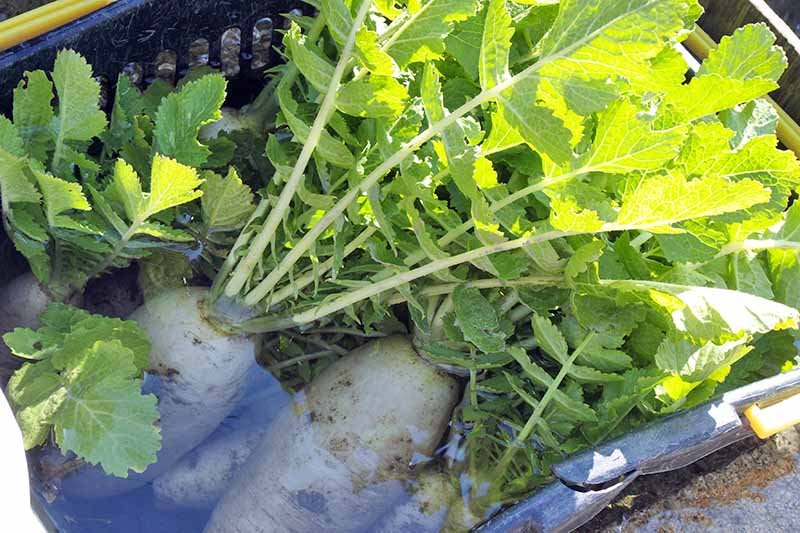
Daikon radish is usually grown in open soil, but it thrives just as well in containers with enough depth. Growing it in a 5-gallon bucket has several advantages:
- Space-saving: Ideal for urban gardeners or those with limited yard space.
- Soil control: You can customize the soil mix to ensure loose, rich, and well-draining conditions for straight roots.
- Pest management: Easier to protect against soil-borne pests and root maggots.
- Mobility: You can move the bucket to the best sunlight position or indoors during harsh weather.
With proper care, container-grown daikon radishes can reach their full size — some even 12 to 18 inches long!
2. Choosing the Right Bucket and Preparation
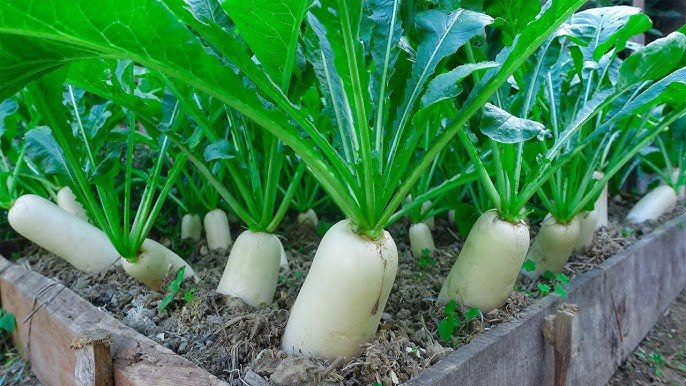
To grow healthy daikon radishes, the container must be deep enough for their long taproots.
Container requirements:
- Size: At least 5 gallons in volume, with a minimum depth of 12–15 inches.
- Material: Plastic buckets or tubs work best since they retain moisture and are easy to move.
- Drainage: Drill 5–6 holes at the bottom to ensure excess water can escape and prevent root rot.
Optional tip: Place small stones or pebbles at the bottom for improved drainage, then fill with soil mix.
3. Preparing the Perfect Soil Mix
Daikon radishes thrive in loose, well-draining, nutrient-rich soil. Compact or rocky soil leads to misshapen roots, so it’s vital to create the right environment.
Ideal soil mix:
- 50% garden soil or topsoil
- 25% compost or well-rotted manure
- 25% coco peat, perlite, or coarse sand for better aeration
Optional additives:
- A handful of wood ash or bone meal to boost root growth.
- Vermicompost for organic nutrition.
Make sure to mix the ingredients well before filling your bucket, leaving about 2 inches of space from the rim for watering.
4. Selecting and Sowing Daikon Radish Seeds
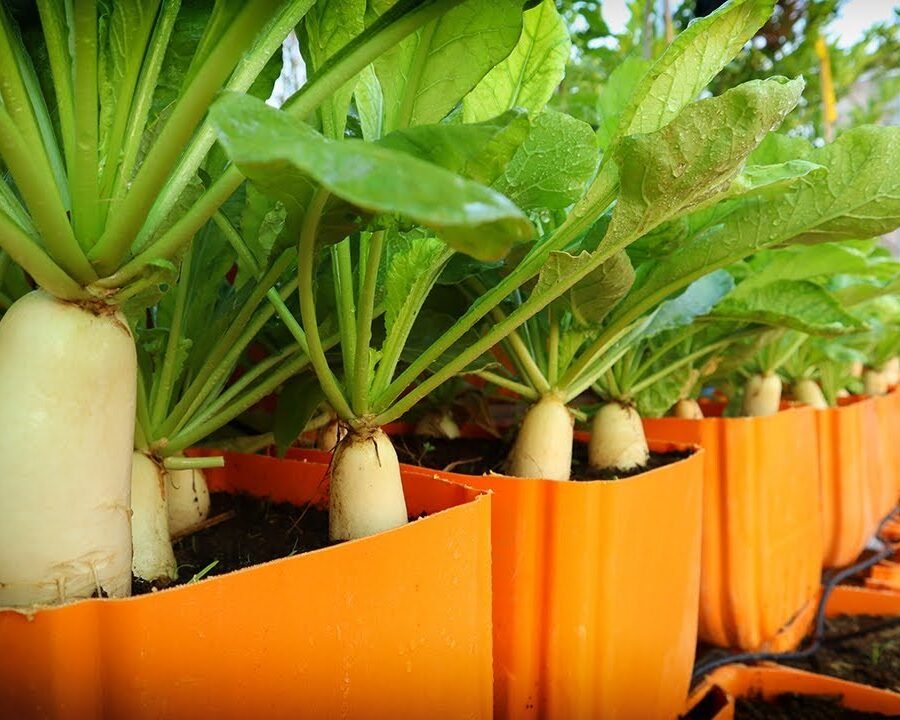
Daikon radishes grow best from direct seed sowing, as transplanting can damage their delicate taproots.
Steps for sowing seeds:
- Fill your 5-gallon bucket with the prepared soil mix.
- Sow seeds ½ inch deep and 2 inches apart.
- If planting multiple seeds in one bucket, maintain at least 4 inches of spacing between each.
- Gently cover the seeds with soil and water lightly.
Germination time: 4–7 days under ideal temperatures (18°C–25°C or 65°F–77°F).
Keep the bucket in a sunny spot, and make sure the soil stays consistently moist during germination.
5. Providing the Right Growing Conditions
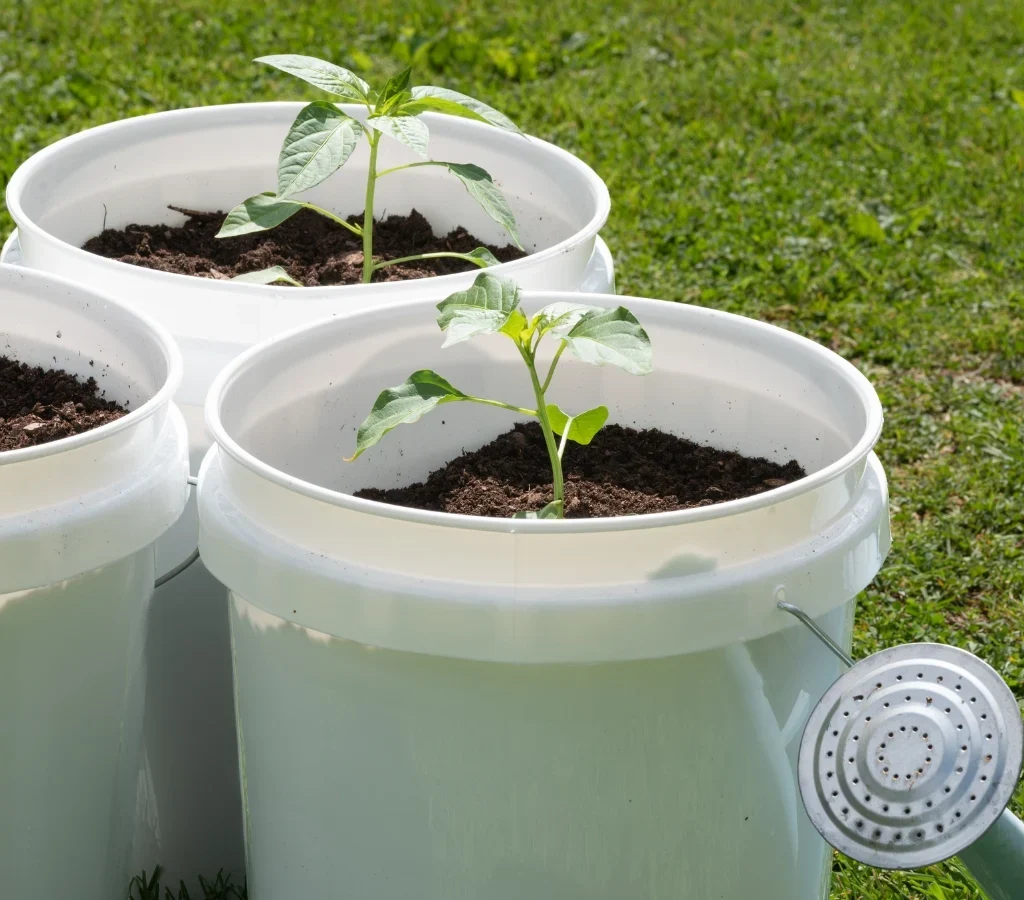
Sunlight:
Daikon radish needs at least 5–6 hours of direct sunlight daily. Place the bucket in a sunny location or under grow lights if growing indoors.
Temperature:
Daikon grows best in cool weather — ideal for fall or early spring planting. The optimum growing range is between 10°C and 25°C (50°F to 77°F).
Watering:
Consistent moisture is key. Water the plant whenever the top inch of soil feels dry, but don’t let the soil become soggy. Uneven watering can cause cracking or poor root formation.
Mulching:
Apply a thin layer of organic mulch (like straw or dry leaves) on the surface to retain moisture and regulate soil temperature.
6. Thinning the Seedlings
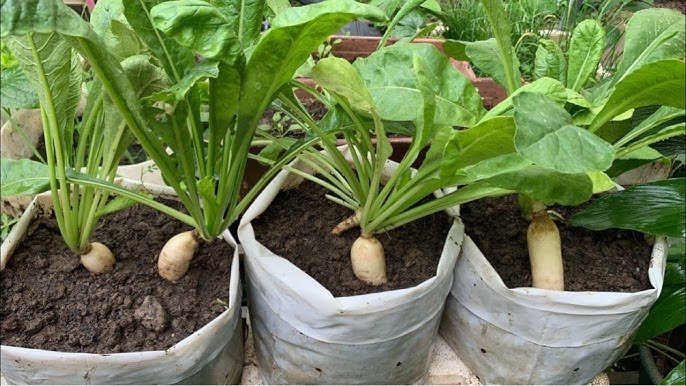
Once seedlings are about 3 inches tall, thin them to ensure proper spacing and healthy root development.
How to thin:
- Remove weaker seedlings, keeping only the strongest ones about 4–6 inches apart.
- Be gentle to avoid disturbing nearby roots.
This step helps prevent overcrowding, ensuring each plant gets enough nutrients and room to grow straight, long roots.
7. Fertilizing for Healthy Growth
Daikon radish doesn’t need heavy fertilization, but adding nutrients at the right time boosts growth and flavor.
Fertilizer schedule:
- At sowing: Mix compost or manure into the soil.
- After 2 weeks: Use a diluted liquid fertilizer or compost tea every 10–14 days.
- Mid-growth: Apply a phosphorus-rich fertilizer (like bone meal) to encourage root expansion.
Avoid excess nitrogen — it promotes leafy growth instead of root development.
8. Pest and Disease Management
Although daikon is relatively hardy, it can be affected by a few common pests and diseases.
Common pests:
- Aphids: Small insects that suck sap from the leaves. Spray neem oil or insecticidal soap.
- Flea beetles: Tiny jumping insects that chew holes in leaves. Use floating row covers or neem oil spray.
- Root maggots: Prevent by keeping soil well-drained and rotating crops.
Diseases:
- Downy mildew and leaf spot: Avoid overhead watering and ensure good air circulation.
- Root rot: Prevent by avoiding waterlogging.
Always check your plants regularly and take prompt action if you notice signs of pest activity.
9. Supporting Healthy Leaf and Root Growth
Both the leaves and roots of daikon radish are edible and nutritious. To promote balanced growth:
- Maintain consistent watering and light exposure.
- Avoid over-fertilizing with nitrogen, as it causes lush foliage but small roots.
- Remove yellowing or damaged leaves to prevent disease spread.
Healthy leaves indicate a strong root system beneath the soil.
10. Harvesting Daikon Radish
Daikon radishes are fast-growing, typically ready for harvest in 50–70 days depending on the variety.
Signs of readiness:
- The top of the white root becomes visible above the soil surface.
- Leaves are lush, green, and slightly spreading outward.
- The root feels firm to the touch.
How to harvest:
- Gently loosen the soil around the base.
- Hold the leaves firmly at the crown and pull the radish upward.
- If the soil is compact, water lightly before harvesting to soften it.
Tip: Harvest promptly once mature — leaving them too long in the soil can make them woody and less flavorful.
11. Post-Harvest Care and Storage
After harvesting, gently brush off the soil and trim the leaves to about 1 inch above the crown.
Storage options:
- Refrigerator: Store in a plastic bag or airtight container for up to 2 weeks.
- Cool, dark place: If kept dry, daikon can last about 10–14 days.
- Pickling: Extend shelf life by making Japanese-style takuan or Korean kkakdugi (radish kimchi).
Freshly harvested daikon radishes are juicy, crunchy, and have a mild peppery flavor perfect for salads, soups, or stir-fries.
12. Saving Seeds for Next Season
If you’d like to continue growing daikon radish, let a few plants flower and set seed.
Steps for seed saving:
- Allow a mature radish to bolt and produce flower stalks.
- Let the seed pods dry on the plant.
- Collect the pods and store the seeds in a cool, dry place for next season.
Seeds remain viable for up to three years when stored properly.
13. Common Problems and Quick Fixes
| Problem | Possible Cause | Solution |
|---|---|---|
| Roots are small or misshapen | Soil too compact or overcrowded | Use loose soil and thin seedlings properly |
| Cracked roots | Irregular watering | Maintain even soil moisture |
| Excessive leafy growth | Too much nitrogen fertilizer | Use balanced fertilizer with more phosphorus |
| Roots turning woody | Left too long in soil | Harvest on time, around 60 days |
By monitoring these issues early, you can ensure healthy, flavorful harvests.
14. Benefits of Growing Daikon Radish at Home
Growing daikon radish in a 5-gallon bucket is not only fun but also highly rewarding. Here’s why you should try it:
- Quick harvest: Ready in under 2 months.
- Nutrient-rich food: High in fiber, vitamin C, potassium, and folate.
- Dual harvest: Enjoy both leaves and roots.
- Compact gardening: Perfect for balconies or patios.
- Eco-friendly: Reduces food waste and packaging by growing your own produce.
Final Thoughts
Learning how to grow daikon radish in a 5-gallon bucket is an easy and satisfying project for beginners and seasoned gardeners alike. With the right soil, regular watering, and sunlight, you can enjoy a steady supply of crisp, white radishes right from your home.
Whether you’re growing for fresh salads, pickles, or Asian recipes, this hardy root vegetable will reward you with abundant harvests and a sense of accomplishment.
So grab a few seeds, a bucket, and get growing — your homegrown daikon radish journey starts today!
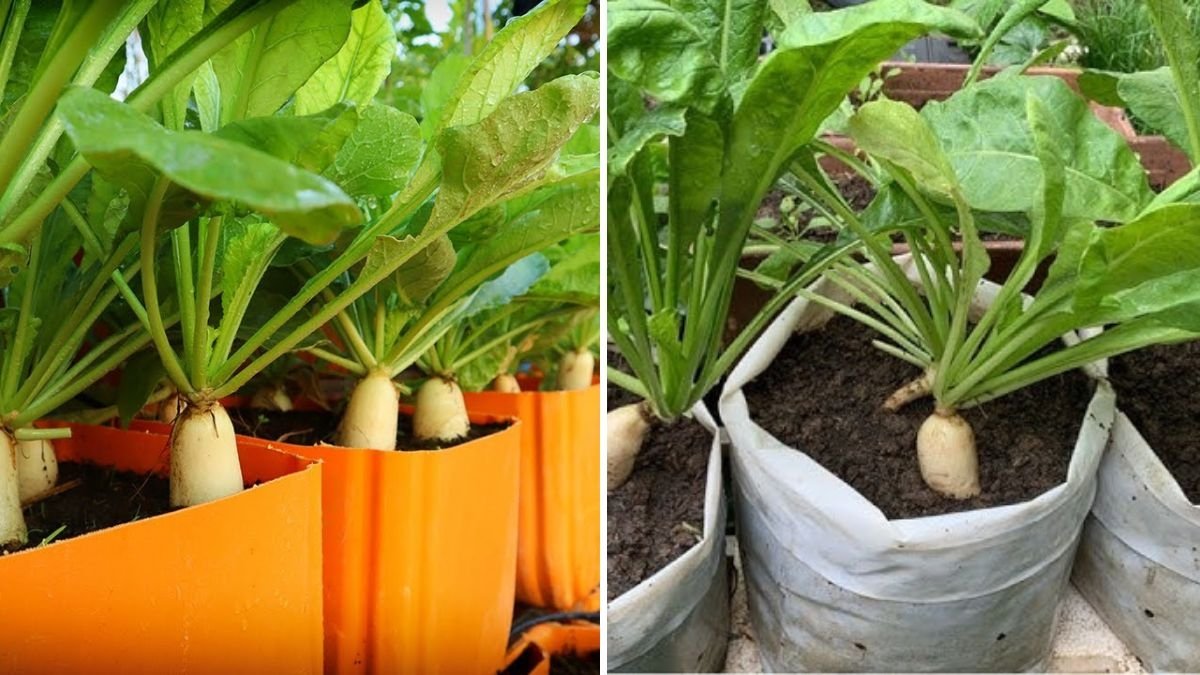

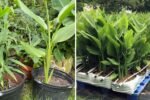



Leave A Comment